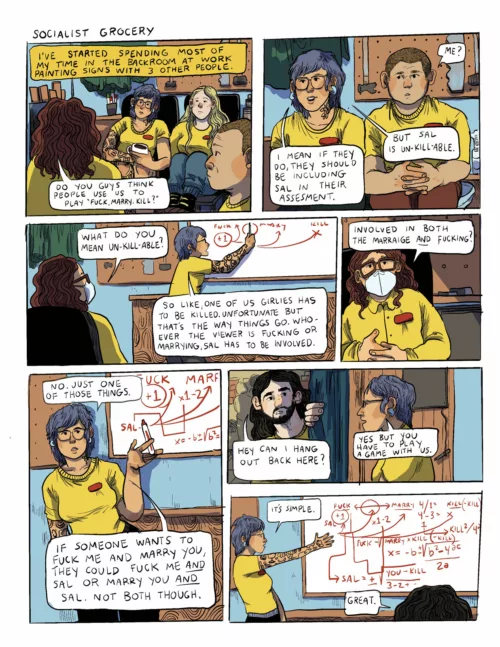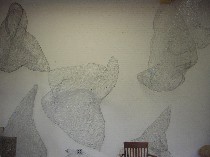
Roberta and I buzzed over to Mei-Ling Hom’s studio two days ago to catch her clouds before they travelled to the main lobby of the Arthur M. Sackler Gallery in Washington D.C. They are travelling by truck in four separate shipments as I write this (right, clouds in the studio, tagged blue for Sackler installation).
The clouds, which are pretty ephemeral-looking bundles of air sheathed in chicken wire, are nearly transparent. They may look ephemeral, but they’ll be up at the Sackler for six months–for an art exhibit, that’s eternity and “storage” said Hom, happy at the prospect of clearing out some space in her studio.
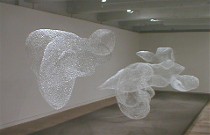
Here’s a post I wrote on the first six clouds Hom made, which are awaiting installation at Philadelphia International Airport (left, clouds installed at Fleisher-Ollman Gallery).
The Sackler is hosting 35 new ones, which will float above (so they don’t interfere with people) and get more and more tightly arranged toward the back of the space where Hom said they would achieve critical mass against the back wall.
Hom greeted us in the huge, South Philadelphia studio just a couple of hours after her silkworms–she had made them as an artist in residence at the Fabric Workshop and Museum–took off for a show at Tufts University. She said her husband, David McClelland, had gone on a mission of mercy to fetch us some cookies.
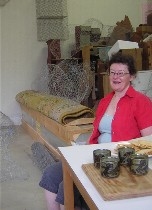 He arrived, pizzelles in hand, while we were still standing near the doorway, and offered us coffee or yao li tea that they had brought back from China. We went for the tea, which tasted earthy and unfamiliar, but thick on the tongue and soothing (right, Roberta, yao li tea and pizzelles in the studio).
He arrived, pizzelles in hand, while we were still standing near the doorway, and offered us coffee or yao li tea that they had brought back from China. We went for the tea, which tasted earthy and unfamiliar, but thick on the tongue and soothing (right, Roberta, yao li tea and pizzelles in the studio).Somewhere amidst this conversation about shipping her art, Hom mentioned that there is a new art shipper that has set up shop at the old Philadelphia Navy Yard.
We learned some interesting facts about China and about Hom and McClelland. For instance, they had visited Gaolin Mountain and the porcelain institute there. Gaolin, which is honeycombed with old mines for extracting the clay, is the same word as kaolin, a particularly pure form of clay. Today, said Hom — or was it McClelland?–the Chinese blast the clay out of the mountain, which has sunk a great deal from the old mines. They were surprised by the mix of ancient water-powered methods and modern factory ones in bringing the clay to market.
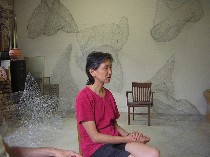 The two visited China on an invitation from Eastlink Gallery in Shanghai to create work for a show aimed at pairing 22 international artists with 22 Chinese artists. “Most of the foreign artists didn’t find a match,” said Hom, although she herself found a partner. Well, even though the pairing concept didn’t always work out, there was a show, which ended up running concurrently with the Shanghai Biennial in the fall of 2004 (left, Hom, clouds and chair in studio).
The two visited China on an invitation from Eastlink Gallery in Shanghai to create work for a show aimed at pairing 22 international artists with 22 Chinese artists. “Most of the foreign artists didn’t find a match,” said Hom, although she herself found a partner. Well, even though the pairing concept didn’t always work out, there was a show, which ended up running concurrently with the Shanghai Biennial in the fall of 2004 (left, Hom, clouds and chair in studio).“Shanghai is the new Prague,” Hom said, later in the conversation, referring to the free-floating ex-pat scene there where the gallery workers included an Indonesian woman from Holland, and woman from Honkong and a woman from Norway with a Chinese husband, both of whom ran a fish-packing company. Thus began the morning’s first conversation about gender roles, the women being “the hind legs of the elephant,” doing the tasks that make gallery and the male gallery owners look good.
At the Sackler, Hom said her clouds, Chinese symbols of good fortune, would be accompanied by music by Eli Marshall. Hom met Marshall when his grandmother, who was taking a ceramics class under Hom at Community College, said, You should collaborate with my grandson. The rest is history.
Marshall ended up doing the compositions both for Hom’s cloud installation at Fleisher-Ollman and for the Sackler.
Marshall had studied composition at Curtis with Ned Rorem, his great uncle, then studied in China on a Fullbright, staying on in Beijing, excited by all the dramatic changes going on there. “He’s an American seeing China and I’m Chinese American…on opposite shores,” Hom said, excited by the fortune of the coincidences.
To create the music while divided by half the world, Hom and Marshall communicated through email. Hom sent images and described the mood of the space and the shape of it. The recording for the Sackler was done in Shanghai with a well-known Shanghai Chinese-flute player (who coincidentally is expected to perform in October at the Kennedy Center with the Shanghai Symphony). The idea is for the sound to set the emotional tone, as in music made for film–what you’d like your audience to experience.
The conversation about Marshall and his grandmother brought the conversation around to the importance of creating connections and having a network in Chinese culture. Marshall is now part of Hom’s network.
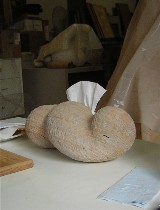 In response to a question, Hom talked about the problem of representing the instability of a cloud. She showed us an early effort, a peanut-shaped cloud of laminated layers of wood, which she made with a hatchet. Delicate hatchet scores are visible on the surface of piece (right, Glu-Lam cloud with tissue rising from the box behind it).
In response to a question, Hom talked about the problem of representing the instability of a cloud. She showed us an early effort, a peanut-shaped cloud of laminated layers of wood, which she made with a hatchet. Delicate hatchet scores are visible on the surface of piece (right, Glu-Lam cloud with tissue rising from the box behind it).“The hatchet was my birthday present to Mei-Ling,” said McClelland, who, being a guy who knows how tools should be used, didn’t really approve of her chopping technique. She ignored his advice.
Hom said she began carving on 9/11 with a dark piece of walnut.
To create the chicken wire clouds, Hom uses needle-nose pliers, and sometimes puts electrical tape on her fingertips to protect them. McClelland called her rhythmic work with the pliers “bug work.” A conversation about bees and drones and lace-making and men’s work versus women’s work ensued. The gender conversation seemed like a way for the two to separate themselves, since they seem symbiotic, two sweet peas nestled in their studio pod.
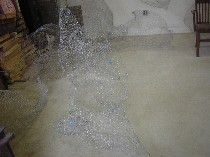 The sheets of chicken wire Hom thinks about as (fabric) pattern pieces with darts when she’s imagining about how to make each shape. She does not use sketches, and she works to music (a pretty eclectic mix from classical to world music) and had the help of a studio assistant, Jaein Pyo, one of her Community College students (left, some clouds scudding across the studio floor).
The sheets of chicken wire Hom thinks about as (fabric) pattern pieces with darts when she’s imagining about how to make each shape. She does not use sketches, and she works to music (a pretty eclectic mix from classical to world music) and had the help of a studio assistant, Jaein Pyo, one of her Community College students (left, some clouds scudding across the studio floor).Roberta asked about the piece for Chinatown that Hom is working on with the Asian Arts Initiative–one of seven major site-specific installations for Chinatown by Asian-American artists, funded by the Philadelphia Exhibitions Initiative. It is called “China Eyes,” and Hom’s plan is for a mural of eyes from the community to watch and be seen on either side of the Vine Street Expressway. Artist Richard Ryan is photographing the eyes for Hom. But the final decisions on the project have not yet been made.
Hom has another cloud project, a walkway for Fleisher Art Memorial also in the works, but we didn’t ask about it, having posted on it quite recently here.
McClelland said before we left, “If you fly to Washington to see the show, you can see the [first six clouds from the Fleisher-Ollman show] at the airport.”
But not yet. First check at the airport’s exhibitions page to see if they’re up yet.






